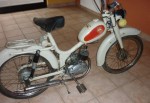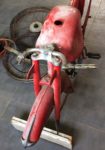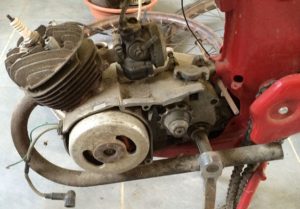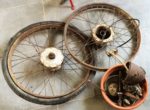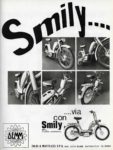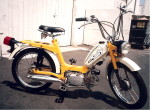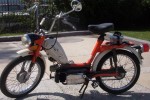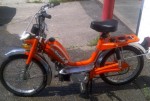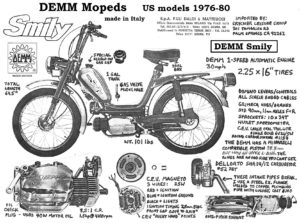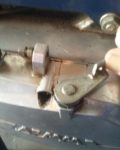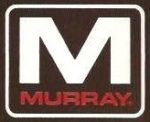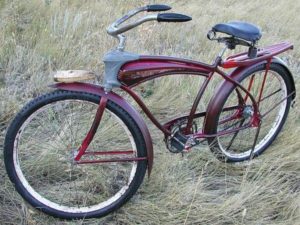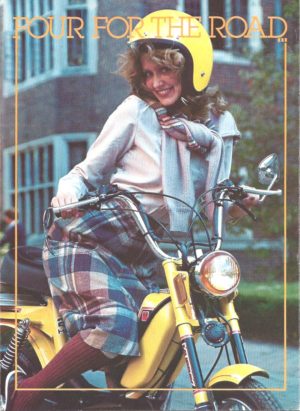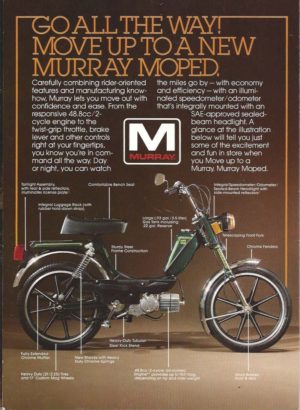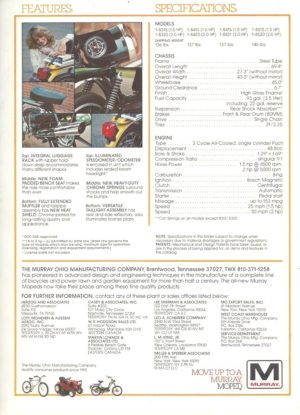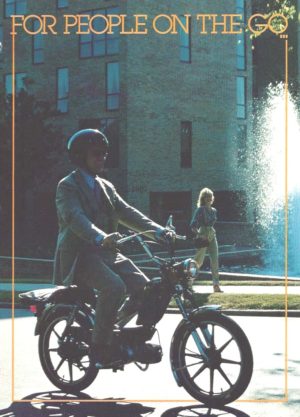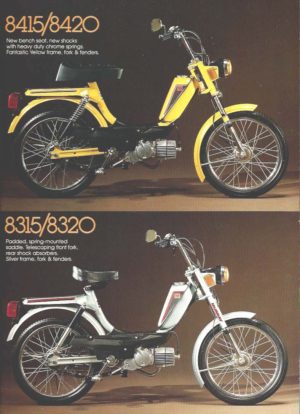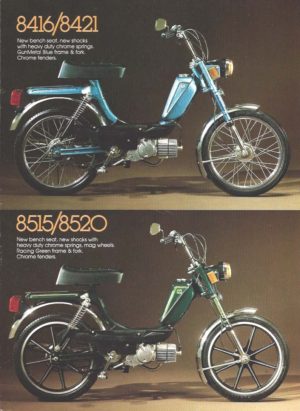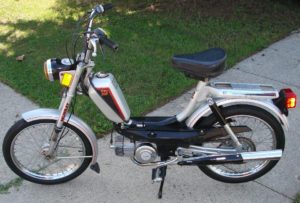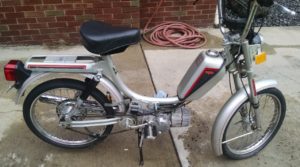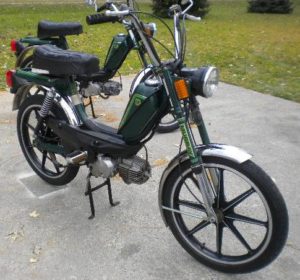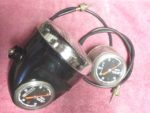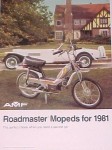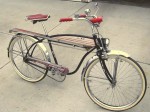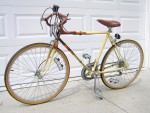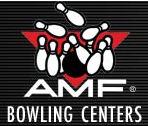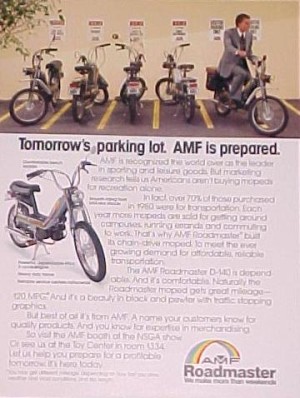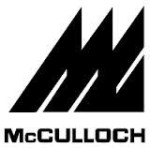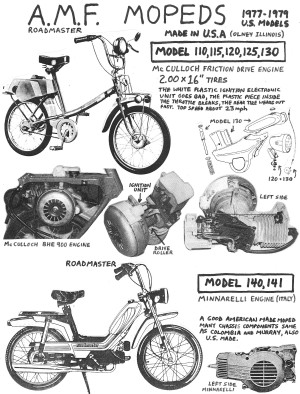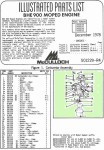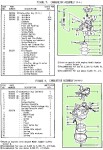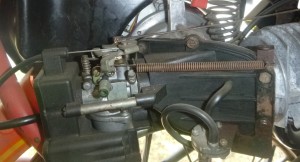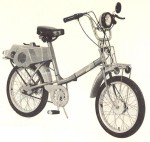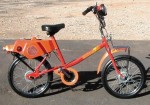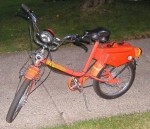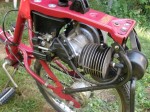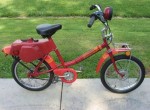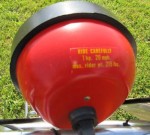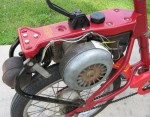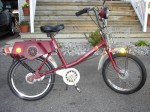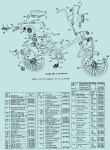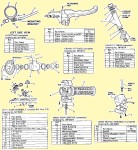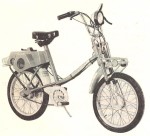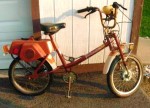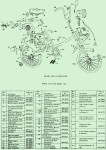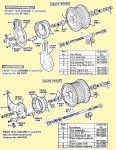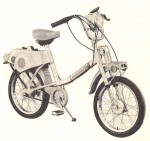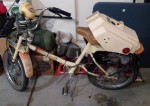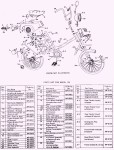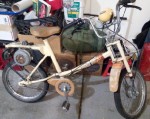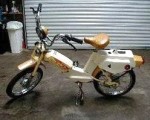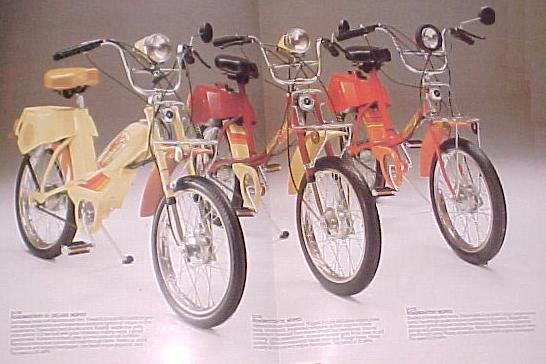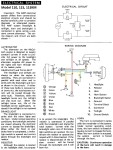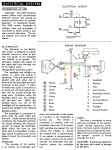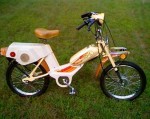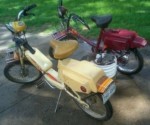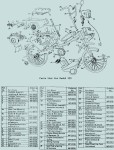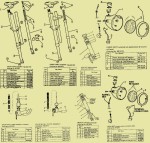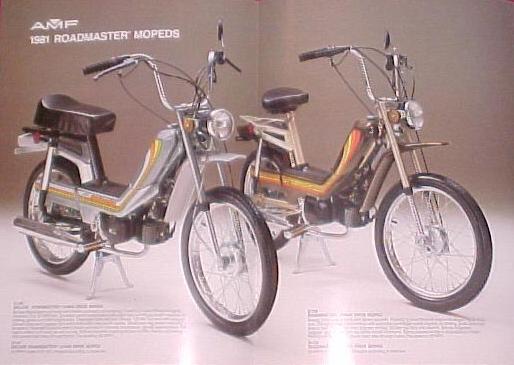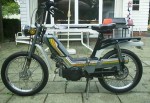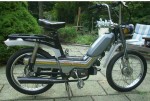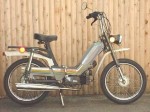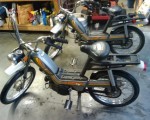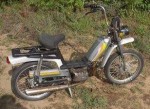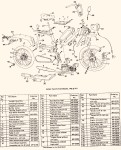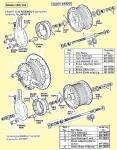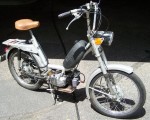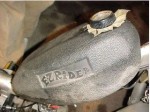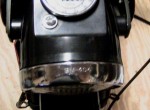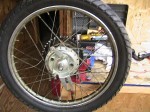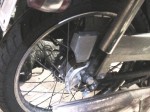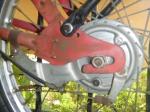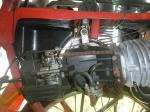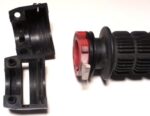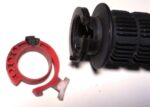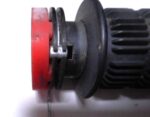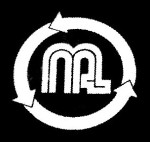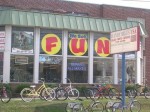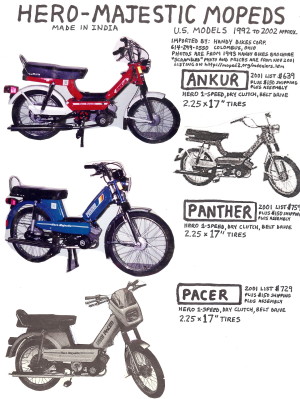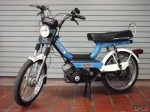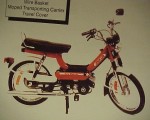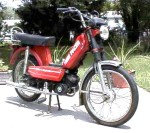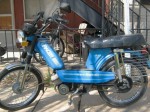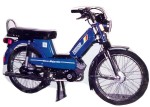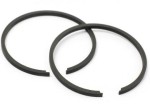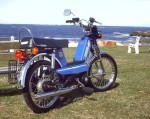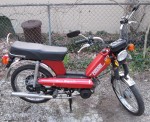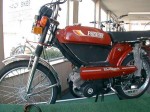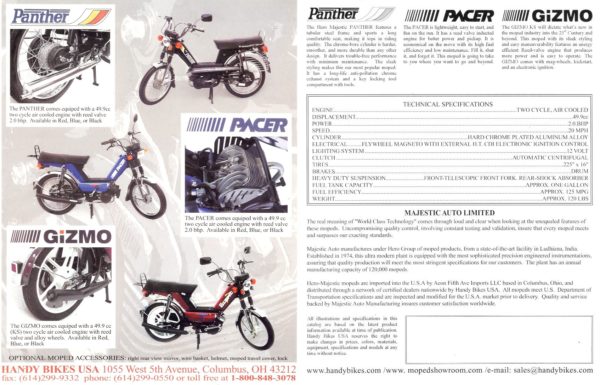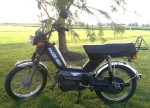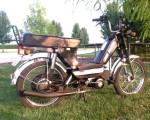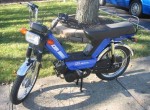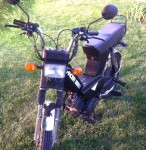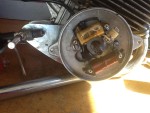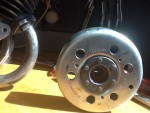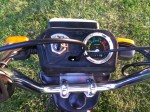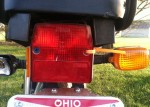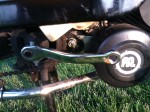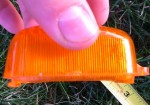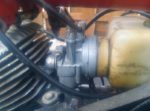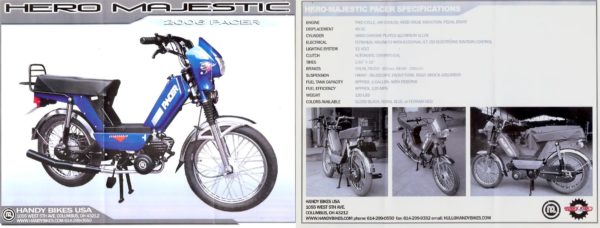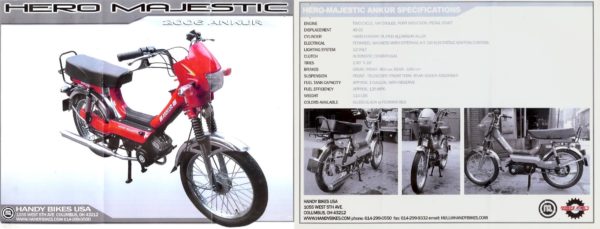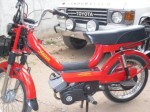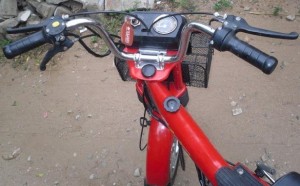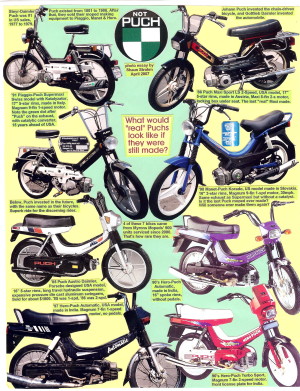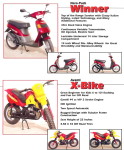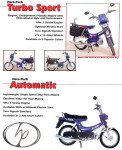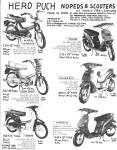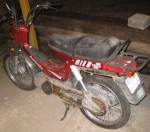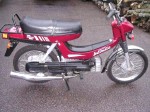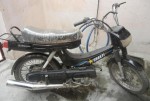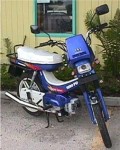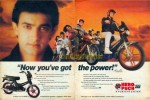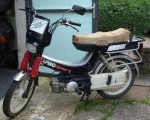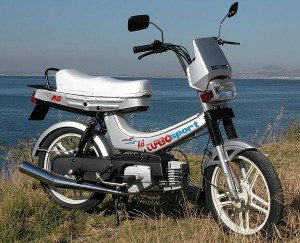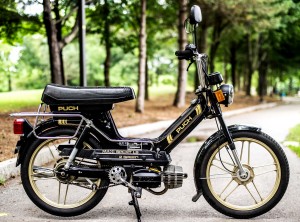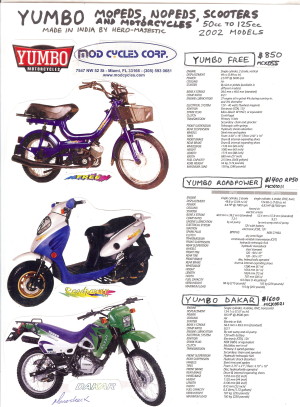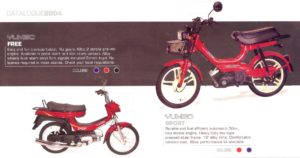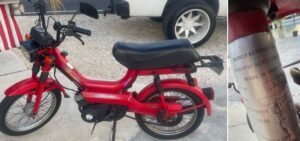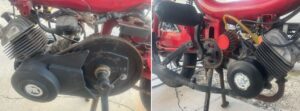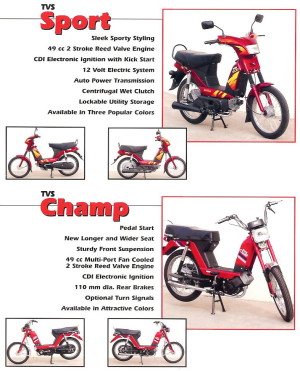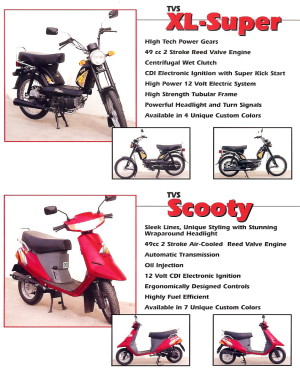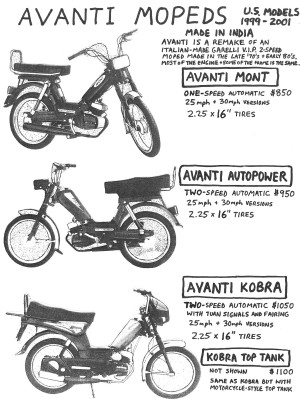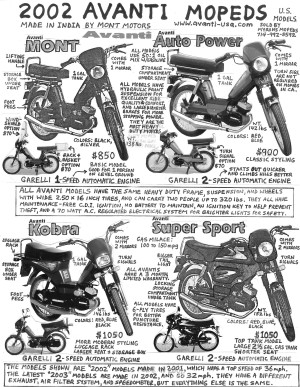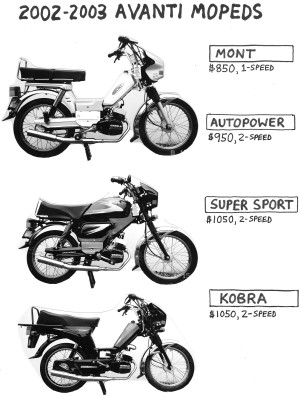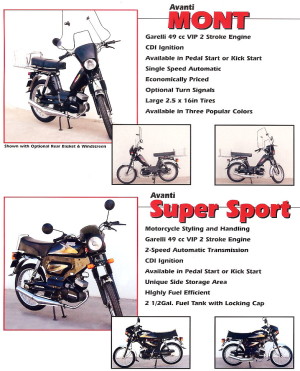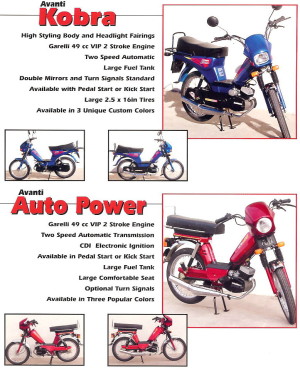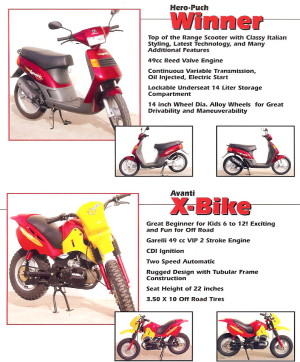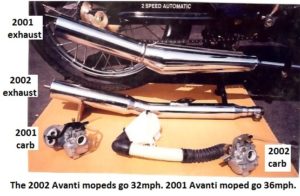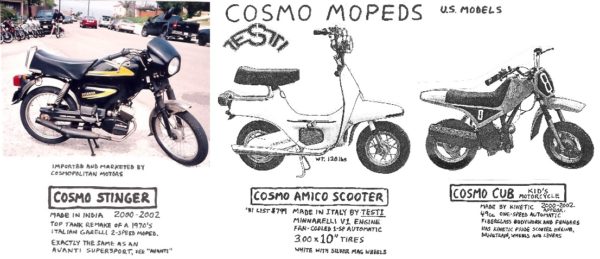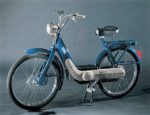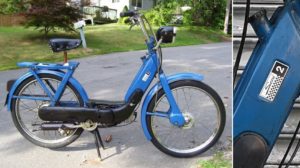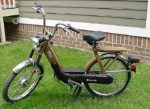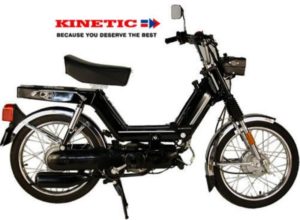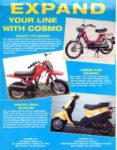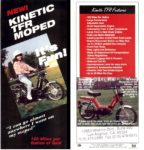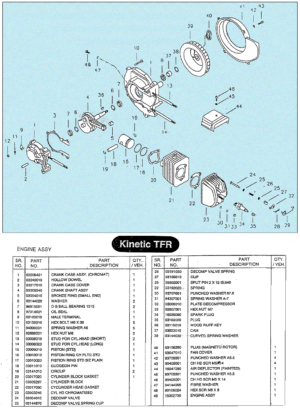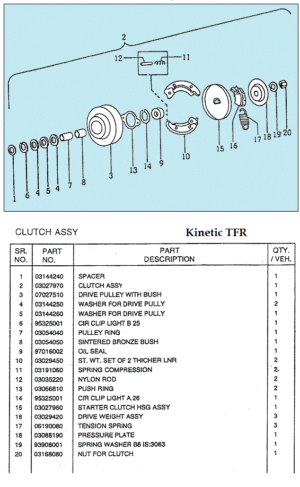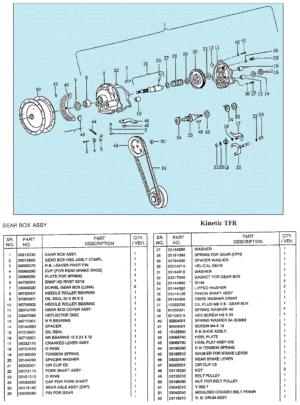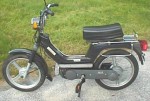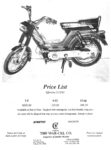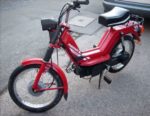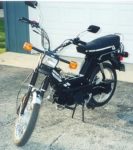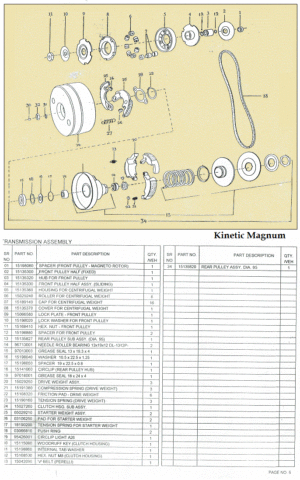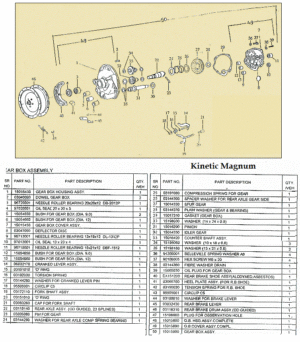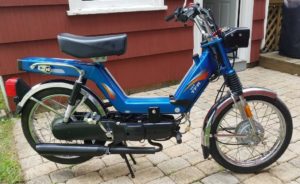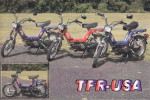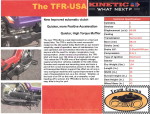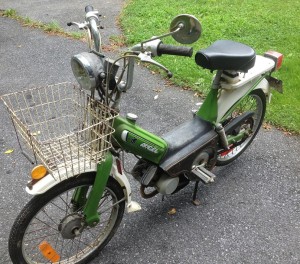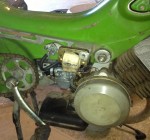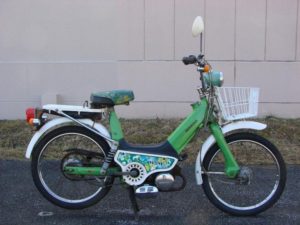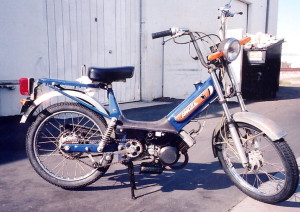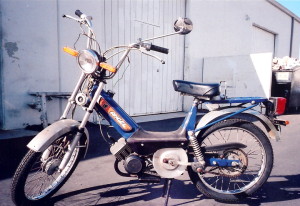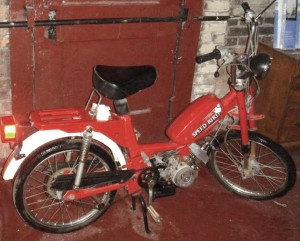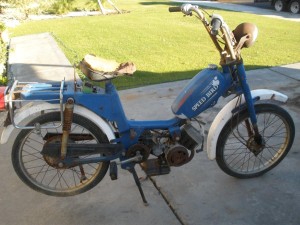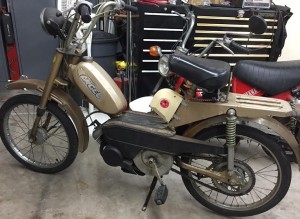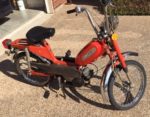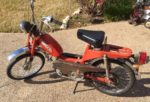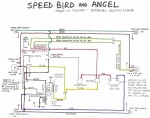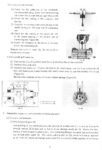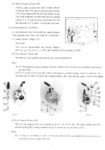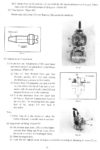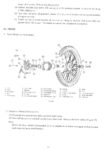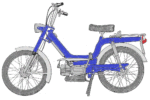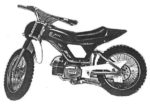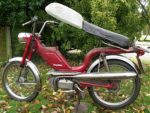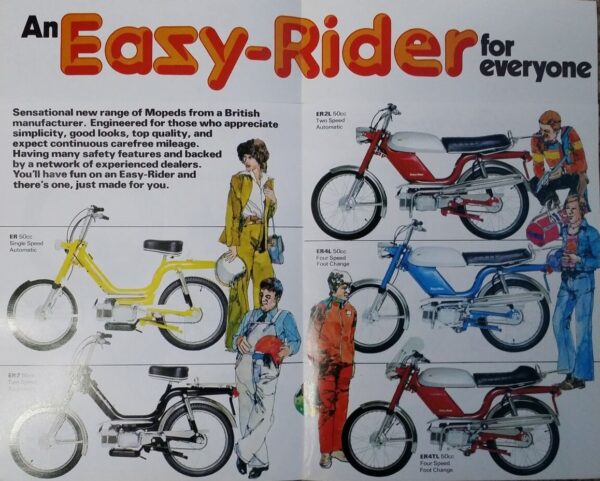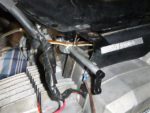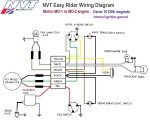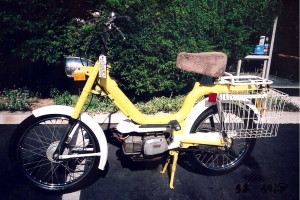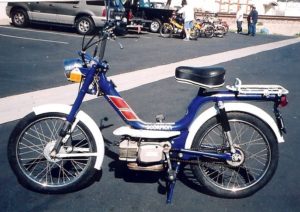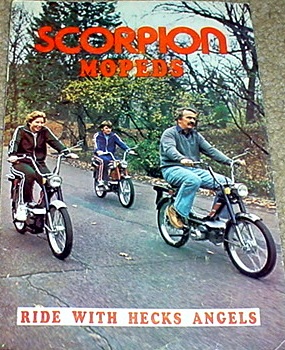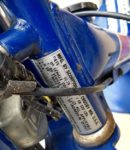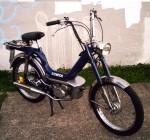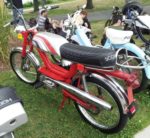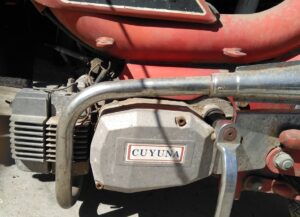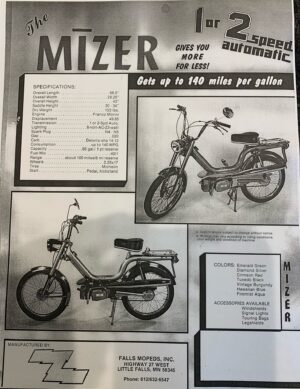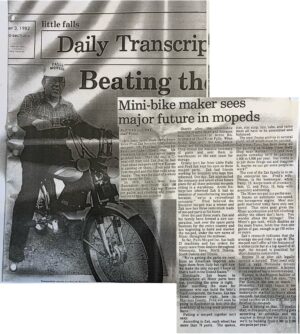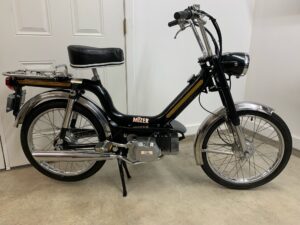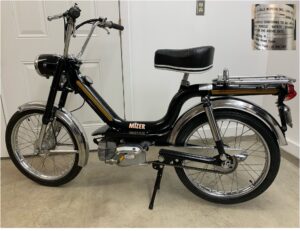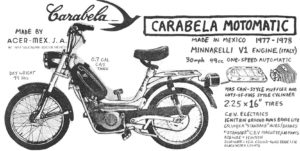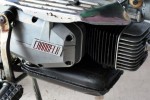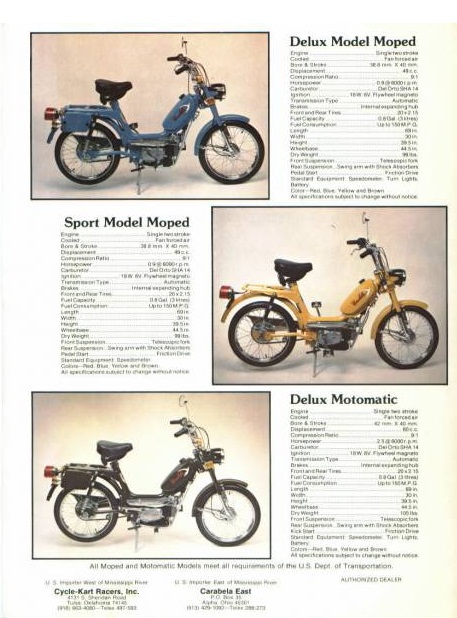 Contents:
Contents:
1. Italjet
2. Indian (USA)
3. Italjet (USA)
4. Engines
 1. Italjet
1. Italjet
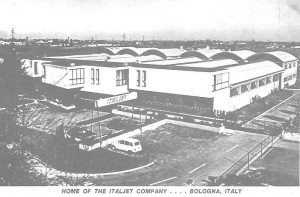
The Italjet factory in the 1960’s, located at 40068 S. Lazzaro di Savena, Bologna Italy.
Italemmezeta was the predecessor of Italjet, a firm established in Bologna, Italy in 1958 by Leopoldo Tartarini, son of Egisto Tartarini, an Italian racer. Early machines employed MZ engines. In about 1966 the firm’s name changed to Italjet. They have built over 150 models of motorcycles and mini-cycles. Italjet sold the complete manufacturing and distribution rights for seven of its scooter models to the Kinetic group of India in January 2007. (from Sheldons Emu).

1967 Italjet Scout, Ranger, Trial, Veloce provided by Primo of Budoia (Pordenone) Italy It says “Champion of Belgium 1966-1967”.
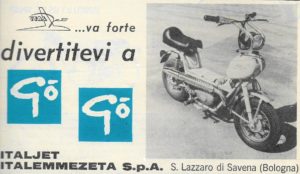
1967 Italjet Go Go provided by Primo of Budoia (Pordenone) Italy. It says “have fun at Go Go”.
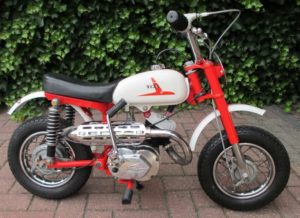
1968 Italjet MM5A Mini Mini, Morini S5K engine, backward-kick, early “4-piece” fork, chrome exhaust, red frame, round number plate
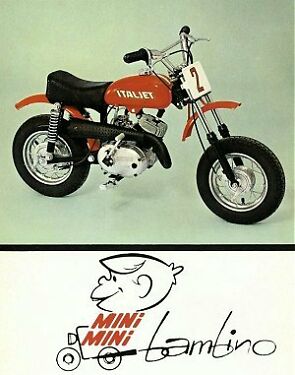
1972 Italjet MM5A Mini Mini, Morini S5K2 engine, forward-kick, late “6-piece” fork, black exhaust, black frame, square number plate
Italjet in the 1960’s and 70’s produced many small motorcycles worldwide that are not shown here. In some markets, some Italjet models were re-branded. In the USA from 1968 to 1976, the MM5A, M5A, JC5A and others were sold under the “Indian” brand. During that early 70’s Indian period, Italjet sold many models worldwide, not covered here.
At some point around 1975-77 the model numbers changed from A to B suffix. The MM5A and M5A became the MM5B and M5B but the equipment did not change on those models.
In the 1970’s round things became square, and chrome or silver things became black, on all types of motorcycles.
 2. Indian (Italjet, Munch, Taiwan)
2. Indian (Italjet, Munch, Taiwan)
 The Indian brand from the early 1900’s was revived in the late 1960’s.
The Indian brand from the early 1900’s was revived in the late 1960’s.
From http://www.indiandirtbikeparts.com/HistoryOfTheIndianDirtBike.html
1968-1970 Floyd Clymer Motorcycle Division (Floyd Clymer) Motorcycle man extrordinaire, Mr. Clymer, dreamed of a reborn Scout and Chief line of the big Indians. What he succeeded most in was the mini models. Imported to keep the Indian name alive and to introduce a younger set to the motorcycling world. Clymer passed away in 1970, leaving his dreams unfulfilled, but successfully bringing the minis to America.
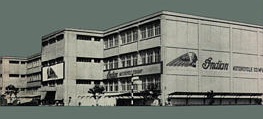
1971-76 Indian factory in Taipei, Taiwan
1971-1976 Indian Motorcycle Co. (Alan Newman) Floyd Clymer’s Los Angeles attorney, Alan Newman, acquired rights to the Indian name and continued importing minicycles made by Italjet. Mr. Newman was a pragmatist and saw the market for mini-bikes, and having acquired the Indian name and logos he contracted with a manufacturer in Taiwan to make Indian mini-bikes from 1971 through 1976. Indian had their own factory in Taipei. Thinking big, Newman planned his own cycle plant, larger 125/175cc models and possible 400cc units came in 1973-74. His assembly plant wound up in Taipei, Taiwan and 70, 75, 80, 100, 125, 175cc engines were imported. Japan (Fuji) engines supplied the 100cc engines. Morini 100’s were used during the Clymer years. 70, 75, 80, 125, 175s were courtesy of Minarelli in Italy. Italjet models (MM5A, M5A, JC5A) used Italian Morini powerplants. Nothing larger than 175s were made except for one 1000cc prototype Indian that based heavily on a Ducati. It was merely for show. Indians’ fortunes were dwindling by 1975. 1976 was the last year of restyling for the 100-175 models. Sales kept dropping and Newman bowed out. The word came out in January 1977: The Indian Motorcycle Company was done.
1969
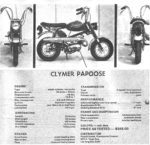
1969 Clymer Papoose, Minarelli P4S engine
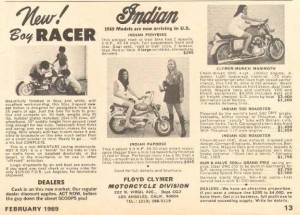
1969 Indian 50-100cc models
made by Italjet (Italy) or Munch (W Germany)
Sold by Floyd Clymer Motorcycle Division
222 N Virgil Av, Los Angeles CA 90004
Papoose (street 47mph 4-s 5hp) Minarelli P4S
Pony Bike (street 47mph 3-s 5hp) Jawa 50-3
Boy Racer (street 50mph 3-s 6hp) Jawa 50-3
Super Scrambler (street 4-speed) Minarelli P4S
Scrambler 100 (street 4-speed) Morini 100
1970
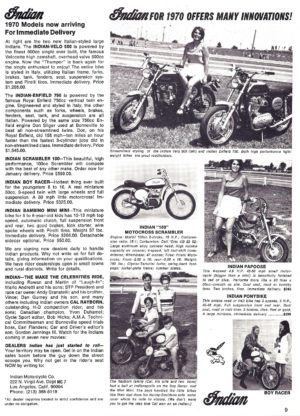
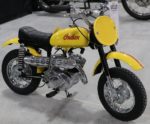
1969-70 Indian Bambino, Franco Morini S5K engine, all-chrome exhaust, early fork
1970 Indian 50-100cc models
made by Italjet (Italy) or Munch (W Germany)
Sold by Indian Motorcycle Company
222 N Virgil Av, Los Angeles CA 90004
Papoose (street 47mph 4-sp 5hp) Minarelli P4S
Pony Bike (street 47mph 3-sp 5hp) Jawa 50-3
Boy Racer (street 50mph 3-sp 6hp) Jawa 50-3
Super Scrambler (off road 4-s 5hp) Minarelli P4S
Scrambler 100 (off road 4-sp 15hp)Morini 101
Bambino (12/20mph 1-s auto 1hp) Morini S5K
1970 mini tanks had Indian script, nothing else. The 1970 Bambino shown in the flyer, that Cal Rayborn’s son is riding, has an early type fork.
1971
 l
l
late-71 to ’72 Indian Mini Mini, Franco Morini (FM) S5K engine, black/chrome exhaust, late fork
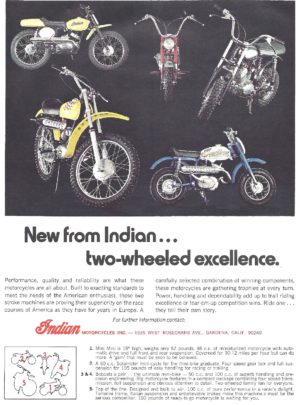
1971 Indian models
made by Italjet (Italy) or Indian (Taiwan)
Sold by Indian Motorcycle Company
1535 W Rosecrans Av, Gardena CA 90249
Scrambler 50 (off road 4-sp 5hp) Minarelli P4S
Scrambler 100 (off road 4s 15hp) Morini 101
Mini Mini (off road 1-sp auto 1hp) Morini S5K
Bobcat 50 ( street 4-speed 5hp) Minarelli P4S
Bobcat 100 (street 4-speed 15hp) Morini 101
1971 mini tanks had Indian script, nothing else. After early-71, mini’s had late type forks. The early-71 shown in the flyer has a early fork.
1972
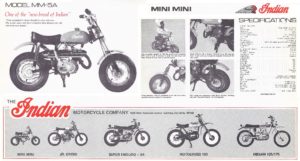
After 1971 all mini’s had all-black exhausts.
1972 Indian line, made by Italjet (Italy) or Indian (Taiwan)
Indian Motorcycle Co. 110 N Doheny Dr, Beverly Hills, CA 90211
MM-5A Mini Mini ♦♦♦♦(off road 50cc 1-s auto 1hp) Morini S5K
JC-5A Junior Cross (off road 50cc 1-s auto 1hp) Morini S5K
JX-54 Junior Cross (off road 50cc 4-speed 5hp) Morini 4MPS
SE-54 Super Enduro (off road 50cc 4-speed 5hp) Minarelli P4S
SE-74 Super Enduro (off road 70cc 4-speed 8hp) Minarelli P4V-70
MX-74 Motocross (off road 70cc 4-speed 8hp) Minarelli P4V-70
X80 Motocross 80 (off road 75cc 6-spd 10?hp) Minarelli P6CS-80
SS-125 Scrambler 125 (street 125cc 6-sp ??hp) Minarelli 125#2
SS-125 MX Motocross (off road 125cc 6-sp ??hp) Minarelli 125#2
1972 MM5A tanks had Indian script, nothing else.
1973
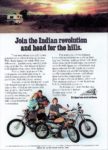
1973 Indian ad
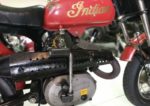
1973 Indian MM5A
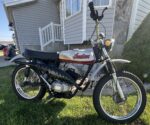
1973 Indian ME76 from Lance Hodgson in Roy, UT
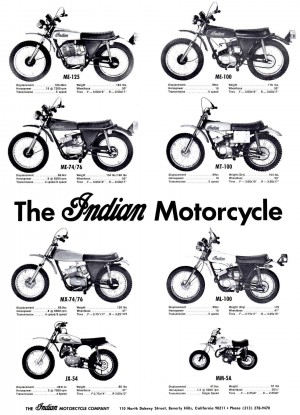
1973 Indian line, made by Italjet or Indian
Sold by Indian Motorcycle Company
110 N Doheny St, Beverly Hills, CA 90211 USA
MM-5A Mini Mini ♦♦♦♦ (off road auto 1hp) S5K2
JX-54 Junior Cross(off road 50cc 4s 5hp) P4E
MX-74 Motocross (off road 70cc 4s 8hp) P4V-70
SE-74 Super Enduro(street 70cc 4s 8hp) P4V-70
ME-74 Moto Enduro (street 70cc 4s 8hp) P4V-70
ME-76 Moto Enduro (street 70cc 6s 8hp) P6R-70
MX-76 Motocross (off road 70cc 6s 8hp) P6R-70
ML-100 Enduro (street 100cc 5s 10hp) F500K
MT-100 Trail (off road 100cc 5s 10hp) F500K
ME-100 Enduro (street 100cc 5s 10hp) F500K
MX-100 Motocross (off road 5-spd 15hp) Mor 101
ME-125 Enduro (street 125cc 5s 19hp) Min125#2
MX-125 Motocross (off road 5-sp 20?hp) Min125#1
1973 tanks had BIG Indian script, nothing else.
1974
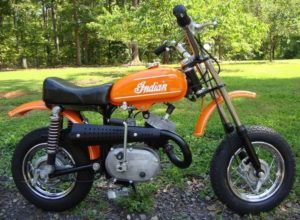
1973-74 MM5A, S5K2 engine, forward kick, all black exhaust
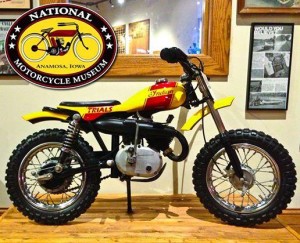
1974 Indian Mini Trials MT-5A, in National MC Museum
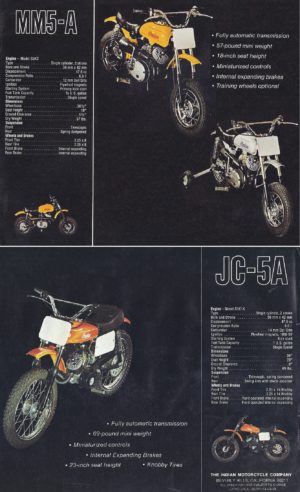
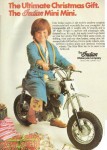
1974 MM-5A
1974 Indian line, made by Italjet or Indian
Sold by Indian Motorcycle Co. Beverly Hills CA
MM-5A ♦♦♦♦ (off road 1-sp auto) Morini S5K2
JC-5A (off road 1-sp auto 1hp) Morini S5K2
MT-5A ( trials 1-sp auto 1hp) Morini S5K2
MX-74 (off road 4-speed ?hp) Minarelli P4V-70
ME-76 ( street 6-speed ?hp) Minarelli P6R-70
MX-76 (off road 6-speed ?hp) Minarelli P6R-70
MT-100 (off road 100 5-s 10hp) Fuji F500K
ME-100 (street 100cc 5-s 10hp) Fuji F500K
ME-125 (street 125cc 5-s 19hp) Minarelli 125#2
1974 MM5A tanks had upper and lower pin stripes.
1975
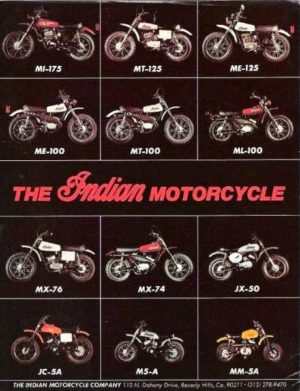
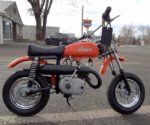
1975-76 Indian MM5A
1975 Indian line-up made by Italjet or Indian
Indian Motorcycle Co. Beverly Hills, CA USA
MM-5A ♦♦♦♦ (off road 1-sp auto) Morini S5K2
M5A (off road 1-sp auto 1hp) Morini S5K2
JC-5A (off road 1-sp auto 1hp) Morini S5K2
JX-5A (off road 1-sp auto 1hp) Morini S5K2
MX-74 (off road 4-speed 8hp) Minarelli P4V-70/75
ME-76 ( street 6-speed 8hp) Minarelli P6R-70/75
MX-76 (off road 6-speed 8hp) Minarelli P6R-70/75
ME-100 ( street 5-speed 10hp) Fuji F500K
MT-100 (offroad 5-speed 10hp) Fuji F500K
ML-100 ( street 5-speed 10hp) Fuji F500K
ME-125 ( street 5-speed 19hp) Minarelli 125#3
MT-125 (offroad 5-speed 19hp) Minarelli 125#3
MI-175 ( street 5-speed ??hp) Minarelli 175
1975-76 MM5A tanks have Indian script, nothing else. So 1975-76 MM5A tanks look like 1969-72.
1976
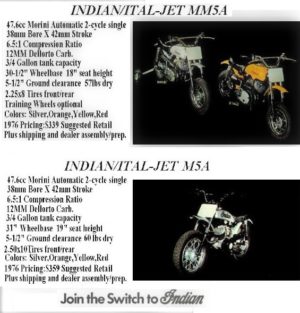
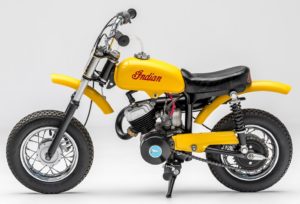
1975-76 Indian MM5A

1976 Indian full size models
1976 Indian line-up made by Italjet or Indian
Sold by Indian Motorcycle Co. Beverly Hills, CA
MM5A ♦♦♦♦ (off road 12 or 20) Morini S5K2
M5A (off road 20 mph auto) Morini S5K2
MS-100A ( street 5-speed) Fuji F500K
MS-125 ( street 5-speed) Minarelli 125#4
MI-125 ( street 5-speed) Minarelli 125#4
MT-125 (off road 5-speed) Minarelli 125#4
MS-175 ( street 5-speed) Minarelli 175
MI-175 ( street 5-speed) Minarelli 175
MT-175 (off road 5-speed) Minarelli 175
1977
1977-78 Indian: Indian Motorcycle Co. ended production in 1976 and closed in January 1977. Any remaining 1976 (or older) inventory would have been sold months later as 1977 or 1978 models. But those “77” or “78” models would have been made before 1977.
Here are three links to indiandirtbikes.com:
Parts lists and manuals Indian lineup ID your Indian
Here is a pdf of Indian dirt bike specs from Sunnymead Cycles in CA.

1973-76 Indian 100-175cc Specs
These latest and greatest Indian two-strokes look like Yamahas, because they are Taiwan designed and manufactured. They use Taiwan and Japan made components. Some component parts are the same as those used on Taiwan mopeds, such as General and Indian:
1) Tatung speedo is same as General
2) instrument lights are same as General
3) Stanley-clone turn signals are General
4) tail light is CEV 9350 like on Italian
5) gas valve is M16-1.5 like Indian/Honda
6) more things to follow
Myrons has some parts for these. But photos and measurements are needed to learn or verify their identity.
In 1977 Indian Motorcycle Company sold the Indian name to American Moped Inc., who used the Indian name on their 4-stroke mopeds made in Taiwan by Merida, produced from 1978 to 1981. Those pedal-assisted Indians are displayed and explained in Brands/Taiwan/Indian.
 3. Italjet Mini-Cycles
3. Italjet Mini-Cycles

Italjet USA 7471 Greenbush Ave, North Hollywood, CA 91605 USA, imported and distributed Italjet mini-cycles in the late 1970’s. The Indian brand name was no longer in use, but they still listed the older Indian model names in their price list.
Strada International, Inc 13148 Saticoy St North Hollywood CA 91605 USA was established in 1975. In the 1980’s they were at nearby PO Box 3816 Van Nuys CA 91407, where they imported and distributed Italjet mini-cycles.
At some point in the 1990’s Italjet merged with Lem, another major Italian mini-cycle manufacturer.
1978-79 Pack-A-Way (5″ rims)
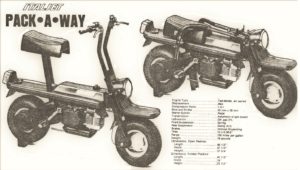
Pack-a-way: This ’78-79 US-model collapsible mini with pedals had a Morini MO-1 engine. It was 1-speed automatic limited to 25mph. List price in 1978 was $599, the same price as a Peugeot 103 or a Puch Maxi.
1980-84 Pack 2 (5″ rims)
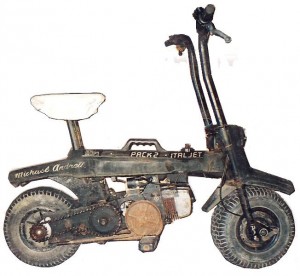
Pack 2: This ’80-84 US-model collapsible mini had foot pegs, kickstart, and a Vespa Ciao engine. It was 1-speed automatic limited to 25mph. It has a carrying handle, and the seat is different. The Vespa engine is very thin, about 2 inches thinner than a Morini MO-1. This made transporting and storing easier. This one was Michael Andretti’s in the 80’s. It was at Myrons for service in the 2000’s.
1978-84 MM5B Mini Mini (8″ rims)
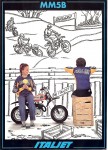
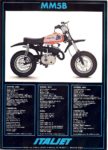
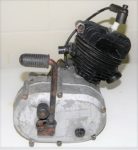
1978 list price $439. tires 2.50 – 8
engine Franco Morini (FM) S5K2
1-speed automatic, bore 38.0mm
horsepower 1.3, top speed 20mph
comp. ratio 6.5, sprockets 11 x 32T, 415H
carburetor Dellorto SHA 14/12
magneto Bosch 0212-005-015
total length 42″, weight 57 lbs
black frame, red tank, black plastics
1978-80 M5B Mini (10″ rims)
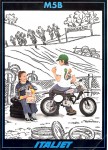
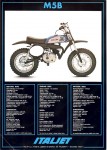

1978 list price $469. tires 2.50 – 10
engine Franco Morini (FM) S5K2
1-speed automatic, bore 38.0mm
horsepower 1.3, top speed 23mph
comp. ratio 6.5, sprockets 11 x 36T, 415H
carburetor Dellorto SHA 14/12
magneto Bosch 0212-005-015
sprockets 11 x 36T
total length 45″, weight 62 lbs
black frame, blue tank, black plastics”
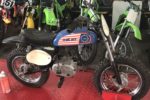
1978 Italjet M5B
1980-84 M5C Mini (10″ rims)
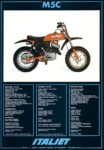
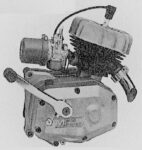
1980 list price $499? tires 2.50 – 10
engine Motori Minarelli G1-KS
1-speed automatic, bore 38.8mm
horsepower 1.0, top speed about 20mph
compression ratio 9.5, sprockets 9(V1) x 35T
carburetor Dellorto SHA 14/9
magneto 80mm, chain 415H,
total length 45″, weight 66 lbs
red frame, red tank, black plastics”
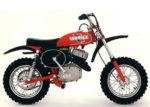
1982-84 Italjet M5C
1982-84? M5D Mini (10″ rims)
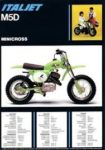

1982 list price $509? tires 2.50 – 10
engine Motori Minarelli G1-KS
1-speed automatic, bore 38.8mm
horsepower 1.0, top speed about 20mph
compression ratio 9.5, sprockets 9(V1) x 35T
carburetor Dellorto SHA 14/9
magneto Bosch 0212-005-027, chain 415H
total length 45″, weight 66 lbs
frame green, tank green, plastics green
1978-80 JC5B Junior Cross (15 and 12″ rims)
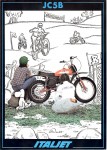

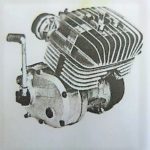
1978 list $519. Tires 2.50-15, 3.00-12
engine Franco Morini (FM) S5R Radiale
1-speed automatic, bore 39.0mm
horsepower 5.0, top speed about 42mph
compression ratio 9.0
carburetor Dellorto SHB 19/19D
magneto Bosch 0212-005-015, chain 415H
sprockets 11 x 48T, dual shocks, total length 54″
1978? black frame, blue tank, black plastics
red frame, red tank, black plastics, wt 82 lbs”
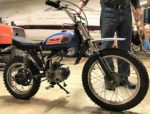
1978 Italjet JC5B
1980-82 JC5C Junior Cross (14 and 12″ rims)
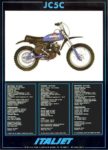
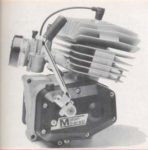
1980 list $529? Tires 2.50-14, 3.00-12
engine Motori Minarelli GR1-KS
1-speed automatic, bore 38.8mm
horsepower 3.5, top speed about 37mph
compression ratio 11.5
carburetor Dellorto SHB 19/19D
magneto 80mm Bosch 6V 18W, chain 415H
sprockets 11 x 48T, rear monoshock, total length 57″
weight 86 lbs, blue frame, blue tank, black plastics

1980-82 Italjet JC5C
1982-84 JC5D Junior Cross (14 and 12″ rims)
The JC5D was the 99% same as the JC5C, except for paint, plastic and stickers.
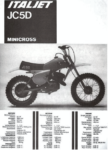

1982 list $549? Tires 2.50-14, 3.00-12
engine Motori Minarelli GR1-KS
1-speed automatic, bore 38.8mm
horsepower 3.5, top speed about 37mph
compression ratio 11.5
carburetor Dellorto SHB 19/19D
magneto 80mm Bosch 6V 18W, chain 415H
sprockets 11 x 48T, rear monoshock, total length 57″
weight 86 lbs, black frame, red tank, white plastics
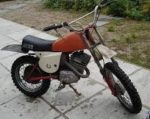
1982-84 Italjet JC5D
1978-79? SX50 Motocross (14 and 12″ rims)
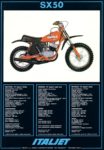

1978 list $529?
tires 2.75-14 front, 3.00-12 rear
engine Minarelli P4E iron cylinder
4-speed foot-shift, bore 38.8 mm
horsepower 4.5, top speed 47mph
compression ratio 9.5
carburetor Dellorto SHB 19/19D
magneto ??mm Ducati, chain 415H
sprockets 13 x 36T, dual rear shocks
total length 58″, weight 105 lb
red frame, red tank, black plastics

1979? Italjet SX50
1978-79 CX50 Motocross (14 and 12″ rims)

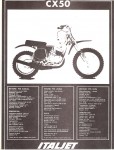

1978 list $569
tires 2.75-14 front, 3.00-12 rear
engine Motori Minarelli P4E iron cylinder
4-speed foot-shift, bore 38.8 mm
horsepower 4.0, top speed about 45mph
compression ratio 9.5
carburetor Dellorto SHB 19/19D
magneto ??mm Ducati, chain 415H
sprockets 14 x 46T, dual rear shocks
total length 58″, wt 105 lb
red frame, red tank, black plastics
1978-79 CX50R Motocross (14 and 12″ rims)
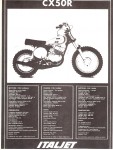
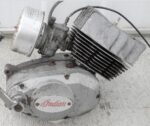
1978 list $699
tires 2.75-14 front, 3.00-12 rear
engine Motori Minarelli P4E alum. cylinder
4-speed foot-shift, bore 38.8 mm
horsepower 5.5, top speed about 50mph
compression ratio 11.0
carburetor Dellorto SHB 19/19D
magneto ??mm Ducati, chain 415H
sprockets 14 x 38T, dual rear shocks
total length 58″, wt 112 lb (thicker fork tubes)
black frame, red tank, white plastics
4. Engines

Minarelli P4
’69-70 Indian Papoose
’69-70 Indian Super Scrambler
’71-71 Indian Scrambler 50
’71-71 Indian Bobcat 50
Minarelli P4E iron cylinder
’72-72 Indian SE54 Super Enduro
’73-73 Indian JX54 Junior Cross
’78-79 Italjet SX50 Motocross
’78-79 Italjet CX50 Motocross
Minarelli P4E aluminum cylinder
’78-79 Italjet CX50R Motocross
Minarelli P4E-70
’72-73 Indian SE74 Super Enduro
’72-74 Indian MX74 Motocross
’73-73 Indian ME74 Moto Enduro
Minarelli P4E-75
’75-75 Indian MX74 Motocross
Minarelli P6-70
’73-74 Indian ME76 Moto Enduro
’73-74 Indian MX76 Motocross
Minarelli P6-75
’72-72 Indian X80 Motocross
’75-75 Indian ME76 Moto Enduro
’75-75 Indian MX76 Motocross
Minarelli 125 #2
’72-72 Indian SS125 Scrambler
’72-72 Indian MX125 Motocross
’73-74 Indian ME125 Moto Enduro
Minarelli 125 #1
’73-73 Indian MX125 Motocross
Minarelli 125 #3
’75-75 Indian ME125 Moto Enduro
’75-75 Indian MT125 Moto Trail
Minarelli 175
’75-76 Indian MI175
’76-76 Indian MS175
’76-76 Indian MT175
Minarelli 125 #4
’76-76 Indian MS125
’76-76 Indian MI125
’76-76 Indian MT125
Minarelli G1-KS
’82-83? Italjet M5C Mini
’83-84? Italjet M5D Mini
Minarelli GR1-KS
’80-82 Italjet JC5C Junior Cross
’82-84 Italjet JC5D Junior Cross
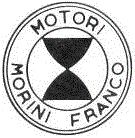
Morini S5K
’68-71 Italjet MM5A Mini Mini
’70-74 Indian Bambino
’72-74 Indian MM5A Mini Mini
’72-74 Indian JC5A Junior Cross
Morini S5K2 link to Indian S5K2 Parts Manual
’72-77 Italjet MM5A Mini Mini
’73-76 Indian MM5A Mini Mini
’74-75 Indian JC5A Junior Cross
’74-74 Indian MT5A Mini Trail
’75-74 Indian JX5A Junior Cross
’75-76 Indian M5A Mini
’78-84 Italjet MM5B
’78-80 Italjet M5B
Morini S5R
’78-80 Italjet JC5B Junior Cross
’75-76 Indian JC5A2 and JT5A2
Morini 4MPS
’72-74 Indian JX54 Junior Cross
Morini 101
’69-70 Indian Scrambler
’73-74 Indian MX100 Motocross
Morini MO1
’78-79 Italjet Pack-A-Way
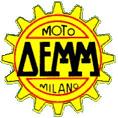
![]() ZSN: Demm was first imported and distributed in the US by ZSN (Zelloe, Sgro, & Neiner, Inc. 351 S Raymond Ave, Fullerton CA 92635 USA), from late 1976 to about 1978. The Demm Scout, with stainless fenders, came from an eastern US distributor, somewhere, possibly ZSN east, PO Box 3176 Annapolis MD 21403 USA. There was also a Demm Smily 2, with ape hangar handlebars and a high back solo seat.
ZSN: Demm was first imported and distributed in the US by ZSN (Zelloe, Sgro, & Neiner, Inc. 351 S Raymond Ave, Fullerton CA 92635 USA), from late 1976 to about 1978. The Demm Scout, with stainless fenders, came from an eastern US distributor, somewhere, possibly ZSN east, PO Box 3176 Annapolis MD 21403 USA. There was also a Demm Smily 2, with ape hangar handlebars and a high back solo seat.
